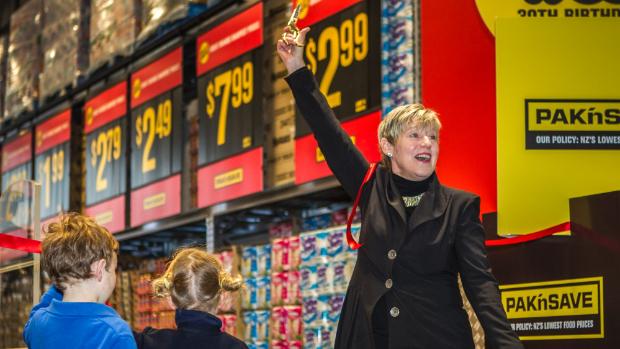Urban design panels' dumb advice revealed in Productivity Commission report

Pak 'n Save Queenstown, not made to look like a fruit-packing shed.
Urban design requirements from councils "lack perspective, consistency, or a sense of their cost", the Productivity Commission said.
Tasked with coming up with a policy package that will enable New Zealand cities to grow fast enough to cope with their burgeoning populations, some of the Productivity Commission's attention fell on the power of urban designers.
In its Better Urban Planning report, published on Tuesday, it highlighted some cases of advice to supermarket chains looking to replace old stores, or build new ones.

Christchurch Mayor Lianne Dalziel officially opens the new Pak N Save store at Wainoni in 2015.
In one, the advice included to build a "dummy" retail shop on the corner of the car park to provide "visual relief", and in another to make space available on its site for rival retailers to give the store a "high street visual feel".
READ MORE:
* Warning to Auckland home buyers: 'The game's over'
The New Zealand Planning Institute has hit back, saying most urban design advice is good, and that urban design was pursued by councils to counter desperately poorly designed developments, especially in Auckland's centre and North Shore.
After the Resource Management Act (RMA) was created, councils across the country started creating urban design standards and establishing urban design panels to offer advice to developers in response to a sharp increase in poorly-designed mid and high density.
But councils' urban design requirements are accused by developers and property owners of adding cost and complexity to developments.
The Property Council New Zealand told the commission: "It is common for councils to place onerous and often complex financial and regulatory visual amenity conditions on development consents. Councils have no understanding of the true financial cost of these and the impact on development viability for a project."
The institute's senior policy adviser Joel Cayford said: "It's possible to criticise urban designers to be a law unto themselves, but they emerge in situations where the planning framework creates problems."
The commission, which favours legal mechanisms to improve councils' urban design controls, said in its report: "Some degree of discretion and variability is to be expected, and may be desirable."
"However, evidence presented to the commission during this and earlier inquiries suggests that urban design requirements or assessments in some cities lack perspective, consistency, or a sense of their cost or economic implications."
It gave four examples of this kind of advice, which supermarkets were given in South Island.
Queenstown PAK'n SAVE, Hawthorne Drive, Frankton Flats: In the resource consenting stage Foodstuffs South Island was encouraged by Queenstown Lakes District Council to seek comment and advice from the local urban design review panel. The panel suggested lowering the entire PAK'n SAVE building below floor level, redesigning the exterior of the PAK'n SAVE to be viewed as a fruit processing shed, and placing a "dummy" retail shop on the corner of the PAK'n SAVE car park, to provide visual relief within the car park.
Ferry Road New World, Woolston, Christchurch: Urban Designers within Christchurch City Council recommended "sleeving" the New World supermarket with competing retailers, and putting the car park at the rear, which would have significant security, operational and crime prevention issues as well as being impractical.
Wainoni PAK'n SAVE, Aranui, Christchurch: Resource consent was needed to rebuild the store after earthquake damage. "Urban designers and the processing consent planner within Christchurch City Council sought to have the application declined on the basis that a Council-owned open-space area adjacent to the PAK'n SAVE would have less visual exposure," the commission reported.
New World, Beach Road, Kaikoura: The resource consent required the New World to be built below the level of the state highway it was on. A subsequent neighbouring shopping centre was not required to do the same. Council officers further sought a mural be painted on the rear of the building so people fishing in the sea would view an ocean-themed mural rather than the green and red colours of New World.
- Stuff